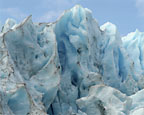|
Stephen Johnson
–
digital landscape photographer
|

|
"
My eyes are in a constant search for ways of translating what I see into a form that holds some representation of the beauty.
" |

|
| |
|
|
|
| |
How were you motivated to choose your particular field? |
| |
I became a photographer from seeds planted long before I seriously picked up a camera. I remember wandering the back country roads of California's San Joaquin Valley and being amazed by the fading horizon and endless space. After a rain the air was so clear I could look west and the towering Sierra Nevada range seemed so close I could reach out and touch Yosemite. Looking back, it is no surprise that I wanted to hold these images, fix them in a way I could point to and say "look, isn't this amazing?" My motivations have not changed much since then.
Landscape photography became for me a great combination of things I loved--being outdoors, loving to make things and a fascination with technology. I now spend much of my time pursuing all three simultaneously, making my high resolution digital landscape photographs in great places like the national parks. In the early nineties, after many years of teaching part-time, I was hired for a full–time teaching position. At a pre-school get together I remember being asked what I would rather be doing. I said I'd rather be in orbit around Jupiter with an 8x10 camera. The natural forms in the dunes of Mars and the clouds of Jupiter still beckon me on. I still long to see with my own eyes the landscapes of other worlds. The order, beauty and puzzle of these unexplored vistas remain a passion for me, just as they did when I was 12 years old, surrounded by a TV, tape recorders, books and magazines for days on end watching the progress of Apollo 11 and our first steps on the moon.
|
|

|
| |
|
|
|
| |
What can you share about your creative process? |
| |

|
|
As I wander the planet, I am keenly aware of light and form. My eyes are in a constant search for ways of translating what I see into a form that holds some representation of the beauty before my eyes, that I can in turn, share with others.
Sometimes I feel like little more than a skilled translator, other times I know that what I've seen and held would be missed by many. I hope that my work is timeless, immune from the stylistic gyrations of modern art judgments. Others will have to make that assessment. I know that the forms and relationships I seek, the natural world we have co–evolved with, reach toward something essential in our heart and soul. The restrained natural color and form of a light-filled pastel world is where my photographs come from, and that is the world I want others to see and appreciate.
Although any art is limited by the technology of its time, I hope that my work is less about the time in history that I lived and the current human condition, than it is about the timeless condition of being a human on the planet Earth. It will be fascinating to see how some of these notions might change as we move to other worlds. I suspect our language will broaden, and we talk about our place as humans moving through the natural forms and wonders of our universe and the notion of home is enlarged.
|
|
| |
|
|
|
| |
What ideas do you have for a future human community on Mars?
|
| |
The most fundamental challenge of building a community on Mars will be finding a way for our needs to co-exist with what Mars naturally is. Everything from the structures we build, to mindsets we base our vision on, must think about the relationship we humans have to build with this new world. Certainly building materials and resources come into play very quickly. But larger issues of the kind of form and structures that seem to have evolved on Mars, and the aesthetics that its own natural forms suggest, must be a part of our fundamental thinking if we are going to make it a home. From there, we stand a much better chance of appreciating what Mars is and learning from its world rather than doing battle with its natural state. If we can appreciate what it is, no doubt whole bodies of artwork can emerge.
As we now think of different styles having a regional origin today, like Southwestern art, we will likely characterize art work as Martian, or perhaps even Martian Polar and Martian Canyon.
|
|

|
|




